
Seven major Japanese trading houses are looking at investing up to $3.9 billion (₱198.5 billion) in different industries in the Philippines.
Asian Business and Economy Informer











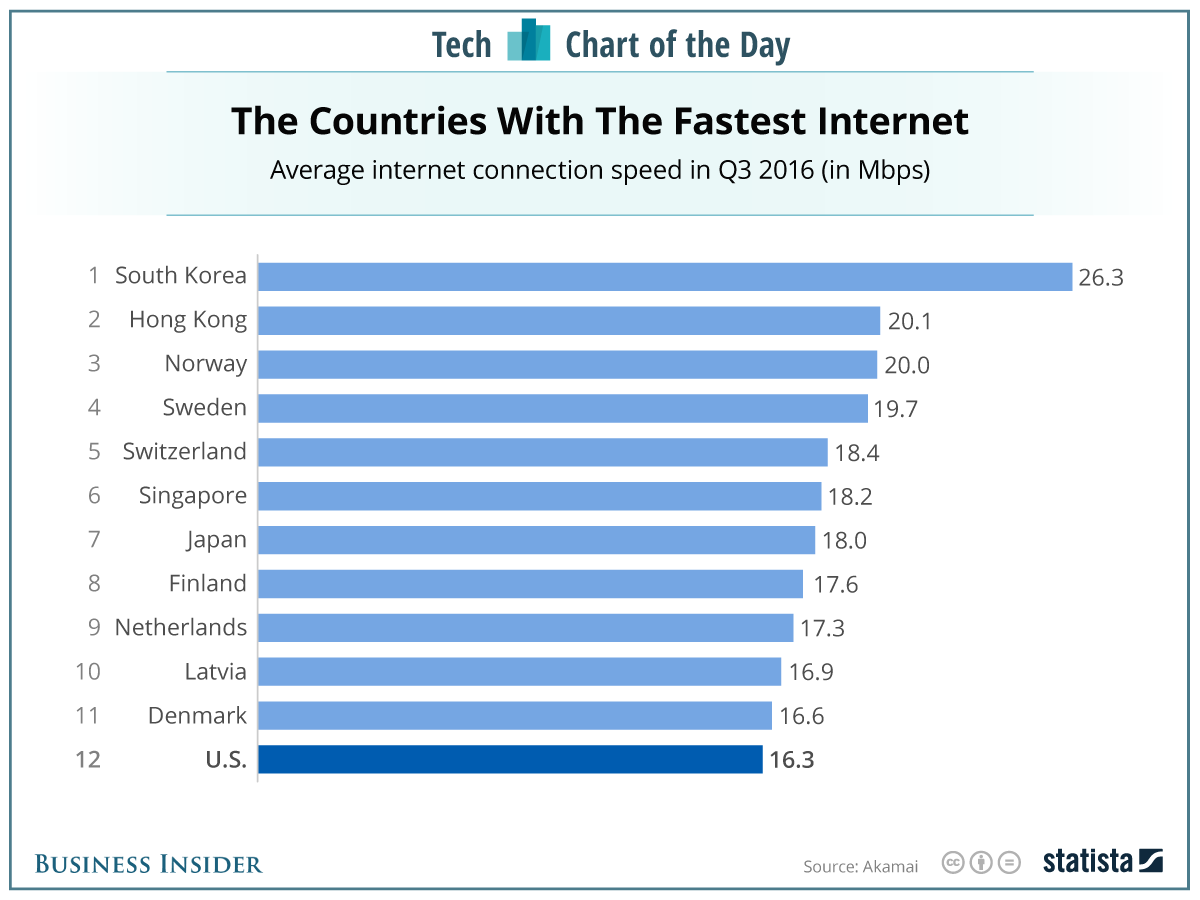 Top 12 World's fastest Internet, South Korea rank no. 1. Illustration Photo: businessinsider.com
Top 12 World's fastest Internet, South Korea rank no. 1. Illustration Photo: businessinsider.com



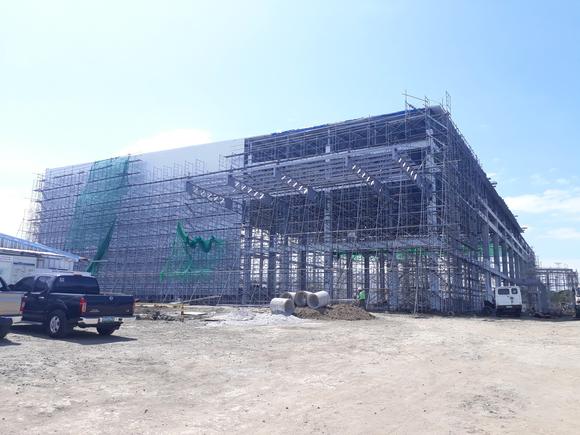



RECORD-HIGH TRUST RATING. President Rodrigo Duterte is trusted by nearly all Filipinos as he begins his term. Photo by King Rodriguez/PPD
Duterte enjoys record-high 91% trust rating – Pulse Asia
MANILA, Philippines: Nearly all Filipinos trust President Rodrigo Duterte as he embarked on his term, according to the results of a Pulse Asia Research, Incorporated survey released on Wednesday, July 20.
The results of the nationwide survey conducted among 1,200 Filipinos from July 2 to 8, showed that 91% of Filipinos trust Duterte, while less than half a percent distrust him, and 8% are undecided on whether or not to trust him.
“President Rodrigo R. Duterte begins his stint as the country’s 16th president with an overwhelming majority of his constituents expressing trust in him (91%) and practically no one distrusting him (0.2%). The rest of Filipinos (8%) cannot say if they trust or distrust President Duterte,” Pulse Asia president Ronald Holmes said.
Former president Benigno Aquino III used to hold the record of the highest level of public trust in the Pulse Asia trust survey first conducted in 1999. In a survey held during a similar period in Aquino's term – July 1 to 11, 2010 – Aquino had a trust rating of 85%.

Data from Pulse Asia Research, Inc
Among geographical locations, Duterte earned the highest trust rating in his bailiwick, Mindanao (97%). Among socioeconomic classes, trust for Duterte is highest among Class D and the poorest Class D, both at 92%.
In a statement, Palace Communications Secretary Martin Andanar said Duterte’s 91%-trust rating during his first week in office “is a humbling reminder that the genuine and meaningful change that our people aspire for is now being felt.”
“This expression of confidence, therefore, shall serve as an inspiration to the Duterte administration to continuously make a real difference and make our people’s lives better, safer, and healthier,” Andanar said.
A Pulse Asia survey conducted in early July also shows that a 'sizeable majority' of Filipinos trust Vice President Leni Robredo

SIZEABLE MAJORITY TRUST. Vice President Leni Robredo enjoys a 62% trust rating in the July 2016 Pulse Asia survey. RAPPLER.com
The survey results also showed that 62% of Filipinos – a “sizeable majority,” according to Holmes – trust the Vice President, while 11% distrust her, and 27% are undecided on whether or not to trust her.
“Most Filipinos – regardless of geographic location and socioeconomic status – say they trust Vice-President Robredo (58% to 72% and 53% to 64%, respectively),” Holmes said.
Among geographical areas, Robredo got her highest trust rating from the Visayas (72%), and among socioeconomic classes, from Class D (64%). Indecision on whether to trust the Vice President is highest in Mindanao (32%) and among the well-off class ABC (35%).
Robredo thanked her countrymen for the overwhelming "vote of confidence."
"We are overwhelmed by the outpouring of support from our fellow Filipinos. From 1% in the pre-election surveys to 35.1% – and now, a trust rating of 62%," she said in a statement.
The survey showed that the primary sentiment toward the Chief Justice is one of indecision, as 42% of Filipinos are undecided on whether or not to trust her. But there are more Filipinos who trust Sereno than distrust her (35% vs 19%).
“Big plurality indecision figures are posted by the Supreme Court Chief Justice in the Visayas (43%) and Class E (46%). On the other hand, the latter receives practically the same trust and indecision ratings in Metro Manila (40% versus 37%), the rest of Luzon (36% versus 46%), Mindanao (38% versus 36%), Class ABC (37% versus 50%), and Class D (38% versus 39%),” Holmes said.
During and immediately before the survey period, among the major news were the oath-taking of Duterte and Robredo, Cabinet appointments including Robredo as housing chief, cases filed against Aquino in connection with the Disbursement Acceleration Program and the Mamasapano clash, and the spate of drug-related killings in the country and calls to probe these.
Around this time, Duterte also expressed his willingness to have bilateral talks and joint exploration with China in the West Philippine Sea (South China Sea), Holmes said.
The nationwide survey has a ± 3% error margin at the 95% confidence level; subnational estimates for each of the geographic areas covered in the survey (i.e., Metro Manila, the rest of Luzon, Visayas and Mindanao) have a ± 6% error margin, also at 95% confidence level.
The July survey also polled the respondents on their expectations of the new administration. (READ: Inflation, jobs edge out crime as Filipinos' top worries – poll) – Rappler.com
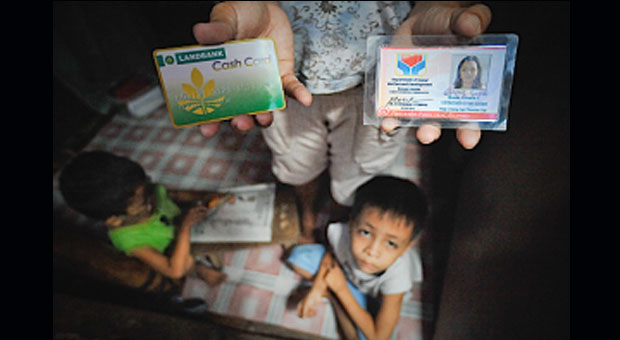
Conditional cash transfer beneficiaries PHOTO FROM BLOGS.ADB.ORG
PH cash transfer program among world’s best–World Bank
The World Bank gave the country’s conditional cash transfer (CCT) program high marks, saying it was one of the “largest and best-targeted social safety net programs in the world.”
Ruslan Yemstov, World Bank’s leading economist on social protection and labor, presented on Wednesday the results of the bank’s “The State of Social Safety Nets 2015” report which showed that 82 percent of the benefits of the Philippines’ CCT program went to the bottom 40 percent of the population and noted that it was “way superior” to previous social programs.
“The poor and vulnerable in the Philippines benefit from what is today one of the largest and best-targeted social safety net programs in the world,” said Yemstov, who led the team that prepared the WB report, said.
Protecting families
Social safety net programs include cash and in-kind transfers to poor households with the goal of protecting families from the impact of economic shocks, natural disasters, and other crises; ensuring that children grow up healthy, well-fed and stay in school; empowering women and girls, and creating jobs.
According to the World Bank report, more than 1.9 billion people in 136 low- and middle-income countries benefit from social safety net programs.
Across the world, CCT programs account for over 50 percent of social safety net programs, and are being implemented in 64 countries—a dramatic increase from two countries in 1997.
The report also noted that CCT had positive spillover effects on the local economy of target communities. Every dollar transferred to beneficiaries generates income ranging from $1.34 to $2.52 in local communities (“multiplier effects”).
Cash transfers boost school enrollment and attendance, increase live births in safer facilities, improve prenatal and postnatal care, promote regular growth monitoring of children during critically important early ages, and enhance food security, the report said.
In the Philippines, almost 4.5 million households are enrolled in the CCT, or Pantawid Pamilya program, from only 360,000 households in 2008.
“CCT grants account for an average of 11 percent of the income of the poorest recipient households,” noted World Bank Country Director Motoo Konishi.
Keep kids healthy and in school
Evaluation studies, according to Konishi, also show that CCT in the Philippines is delivering on its objectives: keeping poor children healthy and in school.
The program increased prenatal and postnatal care by 10 percentage points and increased the delivery of babies in health facilities by skilled health professionals by 20 percentage points. Children benefited by receiving higher intake of vitamin A and iron supplementation by around 12 percentage points and by increased weight monitoring visits to health facilities by 18 percentage points.
Aleksandra Posarac, program leader of the World Bank in Manila, said the Philippines has developed a system “way superior” to previous ones.
She lauded the government’s information management system, called Listahanan,” that identifies who and where the poor are in the country.
Social Welfare Secretary Dinky Soliman, whose agency is the lead implementor of the social safety net program, said the data base, “in a way, makes it corruption-proof.” - INQUIRER

Jayson Castro (William) led the Philippines with 21 points, five rebounds, and two assists. - Photo from FIBA File
A frustrated Gilas Pilipinas bares its teeth and bites down hard on Hong Kong for a strong recovery from a tough loss in the 2015 FIBA Asia Championship
Gilas dusts off loss, mauls Hong Kong by 51
MANILA, Philippines (UPDATED) – A different Gilas Pilipinas showed up on Thursday morning, September 24 than had been on display the day before. And they sent quite a strong message to the rest of the competition.
The 2013 FIBA Asia silver medalists vented out their frustrations from an embarrassing opening day defeat to Palestine as the 69th ranked Hong Kong was the unfortunate victim of a 101-50 decimation in the 2015 FIBA Asia Championship at the Changsha Social Work College Gymnasium in Changsha, China.
Jayson Castro, or Jayson William in international play, showed why he is considered Asia's top point guard, exploding for 21 points, 5 rebounds, two assists. He also was 5-of-6 from three-point land. The speedy Castro was firing on all cylinders as he provided not only offensive ammunition but also stability and leadership in orchestrating Gilas' sets.
Andray Blatche followed up his 21-point outing vs Palestine with a 17-point, 8-rebound performance, while Dondon Hontiveros, after going one-of-6 from downtown in the previous game, found his shooting touch and went 4-of-6 from long range against Hong Kong for 14 points to go with 8 rebounds.
Terrence Romeo added 11 points on 3-of-11 triples to go with 5 rebounds, two assists and a steal. Ranidel De Ocampo chipped 10 points and 7 rebounds.
The Philippine national men's basketball team, ranked 31 in the world by FIBA, bared its teeth and bit down hard on Hong Kong from the get-go as they raced to a 20-2 lead out of the gates thanks to Castro's taking over early on.

TAKEOVER. Jayson Castro, known internationally as Jayson William, stabilizes, leads, and orchestrates Gilas Pilipinas on both ends of the floor from start to finish as the Philippines makes mince meat of Hong Kong. Photo from FIBA
And although Hong Kong, which easily dispatched Kuwait on opening day, found their stride late in the first period, and were backed by the small crowd at the venue, the Philippines refused to be slayed once again and outscored their foes 23-7 in the second period to take a 51-22 halftime lead they would never relent.
The statement game continued in the third even as cheers echoed through the arena for every made Hong Kong shot as Gilas entered the fourth period armed with an 83-38 advantage.
The Philippines' defense was sticky. They clogged the paint and made sure they had active hands and feet all throughout. Unlike the first game, Gilas found the mark from the outside with a 41.2% 3-point shooting clip as opposed to 23% versus Palestine.
After the horrible loss to Palestine, head coach Tab Baldwin dared his players to do more.
"I got nothing for rebounds. That's on you," he said after explaining some adjustments for the Hong Kong game, as shown on a TV5 report.
"If we have to discuss that issue again then I won't be interested in putting my hand in the circle again with you guys. And you guys shouldn't be interested in that too. Fair enough?"
Watch the Video of 2015 FIBA Asia Championship: Gilas Pilipinas vs Hong Kong
"Let's have integrity. Let's do what Filipino basketball players have been doing for years – let's play with puso (heart)," he added.
The team, clearly disappointed during that huddle in practice, responded nicely as they out-rebounded Hong Kong, 62-38. The Palestinians had the edge a day before, 53-58.
Gilas also remembered to move the ball around again and look for the open man as they registered 16 assists, compared to just 8 against Palestine.
They were much more aggressive, too, being smarter with their shot selection. Instead of mostly chucking three-pointers barely 24 hours earlier, Gilas took it strong to the hoop and went 17-of-28 from the line. While that free throw shooting still needs work, they limited Hong Kong to just 5-of-8 from the stripe.
Turnovers were also decreased from 15 to 10.
Siu Win Chang and Duncan Reid led Hongkong with 13 and 11 points, respectively.
Gilas will round up Group B play with Kuwait on Friday, September 25. The team has no room for a loss through to the second round after dropping the Palestine game. – Rappler.com

The group impressed the judges. image: mirror.co.uk
X Factor favorites 4th Power grew up in poverty before shooting to stardom, their mum reveals
The girl group sparked outrage last week as it was revealed they were professionals, but they have come a long way from their childhood
X Factor favorites 4th Power grew up in poverty before reaching stardom, their mum has revealed.
Filipino sisters Almira, 27, Celena, 19, Mylene, 23, and Irene, 25, wept with joy on the opening show after getting a standing ovation from the new judging panel of Simon Cowell, Cheryl Fernandez-Versini, Rita Ora and Nick Grimshaw.
Some viewers were livid when the Sunday People last week revealed they were seasoned professionals.
But life has not always been so good. The girls grew up in a poor neighborhood in the city of Santiago with two more siblings, their junk dealer dad Dominador and mum Erlindo.
Revealing the family's struggle, Erlindo said: "We moved from place to place to find a better life. Poverty forced my husband to buy and sell bottles and newspapers in a pushcart.
"I sold Tupperware, beauty products and fashionwear. With our hard work, we sent our five daughters and our son to school."
She revealed how they got their first break by finishing second in a family singing contest while wearing homemade kit.
The group appeared on This Morning
The sisters raised travel money by singing at an arena between cock fights and went on to perform at birthdays, weddings and concerts to help pay for school tuition.
A string of international competitions followed.
The band had told X Factor producers about their extensive experience before being invited to perform for the judges.- Read more at Mirror.co.uk

image: Inquirer
TAIPEI – Gilas Pilipinas, as expected, rampaged past Chinese Taipei B, 96-67, and secured first runner-up honors at the close of the 2015 Jones Cup invitational basketball tournament at the Xinchuang Gymnasium here Sunday (September 6, 2015).
The Nationals pulled away early and preserved a commanding lead to the finish to end up with a 6-2 win-loss record, a game behind Iran at 7-1.
Gilas Pilipinas pulled off earlier wins over Taipei A (77-69), Spartak-Primorye of Russia (85-71), Japan (75-60), the Wellington Saints of New Zealand (92-88) and USA Select-Overtake (78-74), and suffered losses against South Korea (70-82) and Iran (65-74).
Ahead of the Gilas-Taipei B tiff, Samahang Basketbol ng Pilipinas president Manny V. Pangilinan prodded the Nationals to finish strong, thanking them for the patriotism they stirred on their proud showing here.
“Best of luck Gilas on your last game. Team has generated a lot of goodwill here,” Pangilinan posted on his Twitter account @iamMVP.
“I’m surprised myself at the level of keen interest, and support, as well as a strong sense of patriotism you guys have stirred,” he also said. “Let’s finish strong today; make this country stand taller and prouder. Cheers. Puso!”
The Nationals obliged, capping a performance that coach Tab Baldwin considered “a big step for FIBA Asia.”
“With all the circumstances, I’m pleased with the second-place finish. It’s respectable,” said Baldwin. “It’s not really want you want, but we take the most of it. And there are many positives.”
“Like Iran, Japan and korea, we came here to get better for FIBA Asia. It’s a very difficult format playing eight games in eight days. I think there were positives out of that, but we suffered fatigue and injuries. Importantly, we’ll take the positives from our Jones Cup experience,” he added.
Without a doubt, the Nationals got improvements in so many aspects, putting some of these in display in their lopsided win over Taipei B.
Gary David took his turn to lead the way with a game-high 22 points spiked by two three-pointers while Jayson Castro, Ranidel de Ocampo and Moala Tautuaa contributed double-digit outputs as the Nationals rolled past the young Taiwanese squad for a fifth podium finish here in the last 11 years.
Tautuaa and Calvin Abueva delivered 12 and eight points, respectively, playing their eighth game in eight days here. The two were the only Gilas players who played here without a day’s rest.
Abueva finally got a rest after hurting his back on a bad fall six minutes and 17 seconds into the game.
Subbing for Abueva, Troy Rosario nailed the two gift shots as Gilas seized the lead at 22-21 before eventually pulling away en route to the win and the second-place finish coming after Gilas II’s title run here in 2012.
It’s Team Phl’s eighth podium finish overall in the Jones Cup after four title conquests and three third-place finishes.
Iran recaptured the Jones Cup crown with a 7-1 record, its lone defeat coming at the hands of the Americans when the Iranians rested 7-foot-2 behemoth Hamed Haddadi.
Haddadi threw his weight against the Filipinos, but Baldwin can count on Andray Blatche to match up with the Iranian giant on their rematch in FIBA Asia.
The 6-foot-10 NBA veteran was to arrive here Sunday night and is to rejoin Gilas in practice in Manila starting Wednesday.
Blatche and the entire pool will have three practice days before plunging back into action in the MVP Cup on Friday to Sunday at the Smart Araneta Coliseum. (SB)
The scores:
Gilas 96 – David 22, Castro 15, Tautuaa 12, De Ocampo 10, Abueva 8, Intal 7, Ramos 7, Thoss 6, Rosario 6, Ganuelas-Rosser 3, Norwood 0, Taulava 0.
Taipei B 67 – Chien 18, Hsiao 14, Lin 9, Lee 9, Huang 8, Lee 3, Liu2, Lin CW 2, Chen 2, Chou 0, Cheng 0, Chien 0.
Quarterscores: 24-21, 50-32, 82-52, 96-67 - INQUIRER
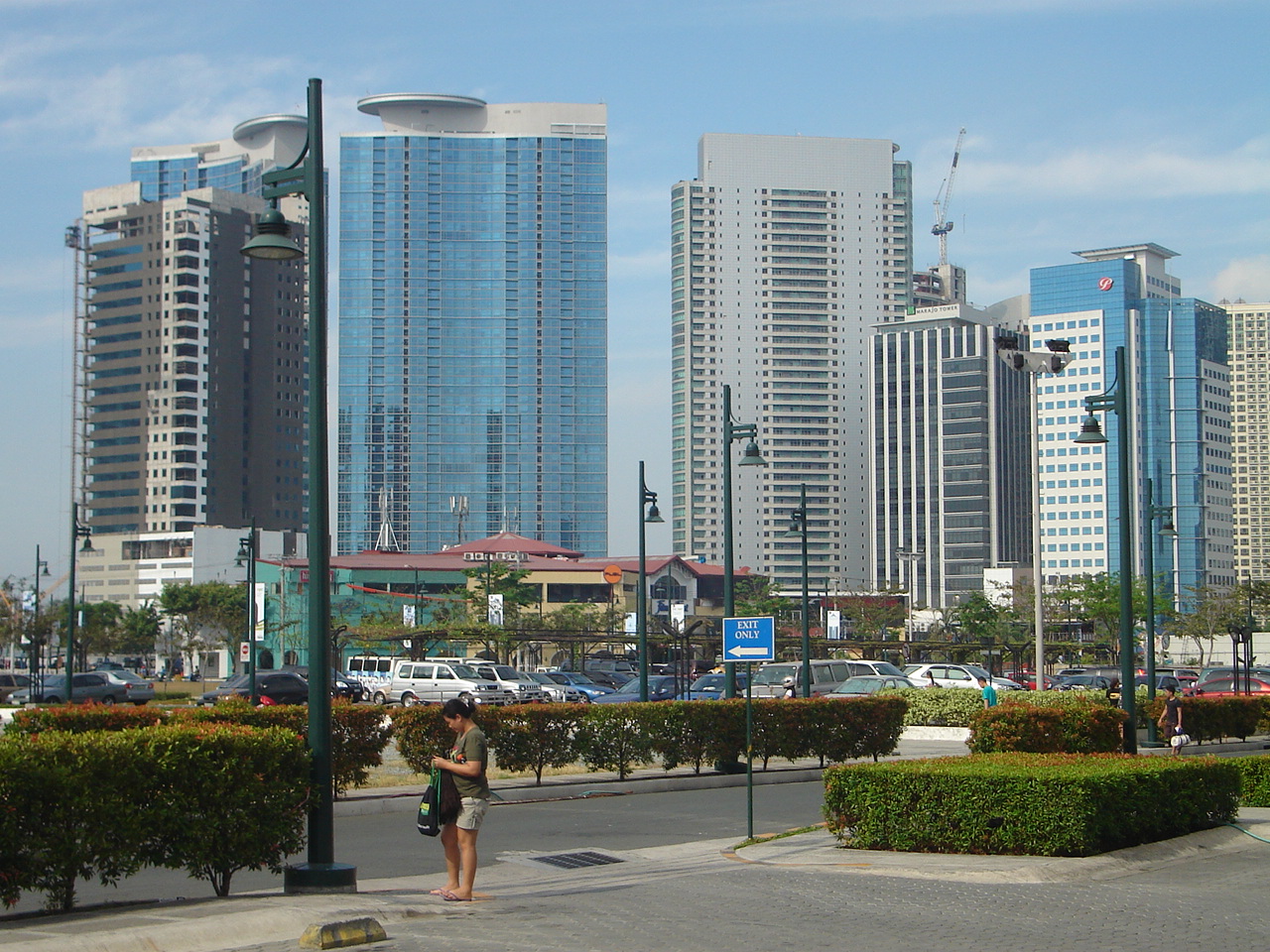
Bonifacio Global City (BGC) Taguig, Manila, Philippines - image: pilipinohomes.com
Philippine Unemployment Rate ASEAN’s Highest, but Why?
Even though recent years have seen rapid economic growth in the Republic of the Philippines, a high unemployment rate has persisted for quite a while in this sprawling Southeast Asian nation with a population of over 100 million people.
Under President Benigno Aquino who has been in office since 2010, the unemployment rate has fallen. The last reported figure was at the rate of 6.4% during the second quarter of this year, 0.6% less than the 7% reported a year earlier. However, the progress has been slow and unstable with the Philippines still having the highest unemployment rate in the ASEAN region.
There are many reasons for this. Invest Asian citing top reasons based on research.
" Main one being that the country’s population is growing faster than the rate at which jobs are being created"
In three of the past five years, official statistics show that the number of people entering the job market has been greater than the number of jobs created.
The conundrum highlights the difficulty and complexity of spreading the benefits of economic growth and points out that they have yet to trickle down to more deprived areas of the nation.
Filipinos Just Aren’t Working
Another reason is even more alarming. There is relatively lower working population compared to neighboring countries. This means that even if the unemployment rate falls, it does not ensure maximum productivity of the country.
As mentioned, the participation in the labor force remains relatively low. But what is it in quantifiable numbers?
"Only about 65% of the population aged 15 and above is looking for work "
The number being one of the lowest in the region. To put the number into perspective, the numbers in Vietnam, Thailand, and Indonesia are 78%, 72%, and 68% respectively.
One possible explanation for this low labor force participation percentage is that there is a higher value placed on further education in the Philippines. What this means is that young Filipinos typically spend some more time in college before entering the labor market, directly contributing to the low participation rate. The citizens of the other countries in the region enter the workforce much earlier.
Not Enough Good Jobs?
Yet another alarming reason could be the low quality of jobs available. In 2014, less than half of workers – in both formal and informal employment – were in what were described as paid jobs. Of the rest, about a fourth were self-employed with no guaranteed income and a tenth were in their family business working on farms or other businesses where they typically received food and lodging but no real cash, according to official statistics.
Former budget minister and current economist at the University of the Philippines, Benjamin Diokno, says that this relatively large number of unpaid workers – about 4 million people – “bloats” the ranks of the employed and makes the unemployment rate seem less serious that it really is.
However, such unpaid workers are not the only ones feeling held back.
In a government survey, 18% of workers said that they would like to work longer hours or get an extra job. Only 35% of these worked 40 hours or more a week.
The Philippine government, in an effort to mirror the success of its Asian neighbors, is looking to improve the quality of jobs available by ramping up employment in manufacturing. But it has had little success so far, hindered by issues such as higher wages, limited infrastructure and red tape, which make the country less competitive than its ASEAN peers.
Their lack of success is proven by the fact that only 16.5% of workers were in industrial jobs in the second quarter of 2015.
The country’s uneven employment market has traditionally led millions of Filipinos to seek better-paying jobs overseas. One out of every 10 Filipinos works abroad, sending billions of dollars in remittances home and helping to drive the country’s consumption-driven domestic economy – but doing little to promote employment.
There does not seem to be an end (at least in the near future) to the high unemployment rate problem that the Philippines faces.- Invest Asian
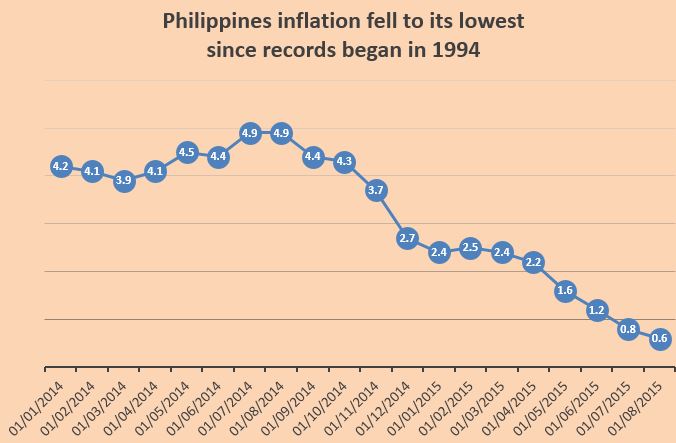
Image source: The Financial Times
If you need evidence that the world faces a "third deflationary wave," look no further than the Philippines.
Annual inflation in the Philippines was just 0.6 per cent in August, the lowest reading in more than two decades of records. Economists had forecast a 0.7 per cent reading, following a 0.8 per cent print in July.
The central bank targets headline inflation target at 3 per cent, plus or minus one per cent. Actual inflation has come in below that band for four months.
The downward trajectory in inflation across much of Asia reflects weak demand, lower commodity prices and a decline in costs for manufactured goods. Currency devaluation has done little to thwart the deflationary threat: the Philippines' peso has depreciated more than 15 per cent since March 2013 and now trades at ₱ 46.79 per dollar, about 8 per cent weaker than its five year average.
Core inflation, which strips out volatile items to get a better sense of underlying trends, looks a little better on the whole but its August reading was well below forecasts. In August the reading was 1.6 per cent year-on-year, versus forecasts at 1.9 per cent. The downward trajectory is clear: in March the reading was 2.7 per cent; one year ago it was 3.4 per cent.
A quarterly index of consumer price inflation across Asia (ex-Japan) confirms this trend is found across the continent. The second quarter reading of 2.06 per cent was about half the rate seen in 2012 and a two-thirds below the rate in 2011. As explained in the FT earlier this week, these trends are likely to intensify as the Federal Reserve lifts interest rates, causing the US dollar to rise and yield-seeking investors to take cash out of emerging markets.
"In sum," wrote Dominic Rossi, global chief investment officer at Fidelity Worldwide Investment, "this third deflationary wave will mean that world GDP will continue to operate at a level below potential output. Downward pressure on prices will persist and a supply-side contraction in developing nations will be required before prices stabilize. A further fall in potential global output is now unavoidable. The adjustments to GDP forecasts are still ahead of us." - The Financial Times